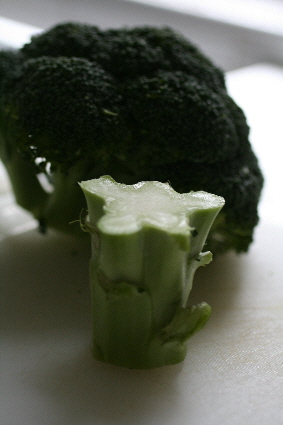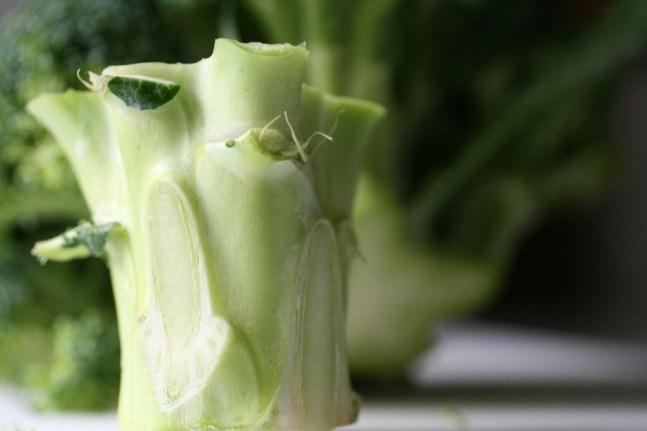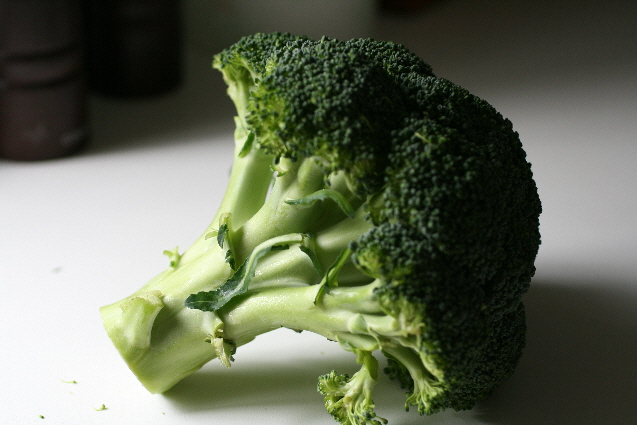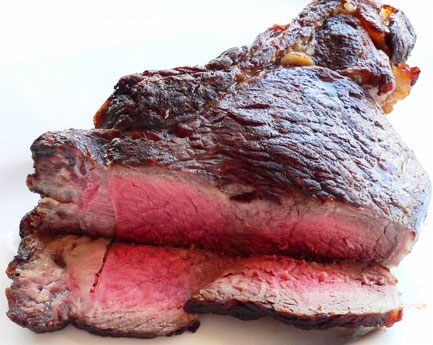I’m not sure if it was broccoli or brussel sprouts that I hated more as a kid. Boiled to the point of going grey, as was the cooking technique of the day, all I can recall was a nauseating taste and practically gagging as my parents forced me to “Eat my greens”.
With a New Zealand upbringing and parents that were so orthodox in their eating habits I did not discover garlic until I left home, which in reflection is a culinary tragedy and like many Anglo Saxons I had a gastronomic epiphany when introduced to more European and Asian cooking methods and flavours.
I now relish broccoli, ironically purely steamed, although often run it through the wok with some olive oil and garlic. If only that’s how my parents cooked it, I would have been spared all that ghastly food torture.
Still, there is one facet of broccoli cultivation that I have yet to come to terms with – eating the stalks.
And I suspect I am amongst the millions, or maybe even billions of people on the planet who do not eat the broccoli stalk.
This could again relate to my conservative culinary upbringing as we only ate the florets, throwing away the stalk. However, when shopping recently at a (Singapore) supermarket and dismayed at the price of broccoli, discontent lead to curiosity instigating some basic research revealing there are broccoli stalk eaters out there, least in theory.
Content on the worldwide web largely points to peeling off the outside layer of the broccoli stalk, presumably too fibrous and tough and then slicing thinly, preferably with a mandolin, and adding to your stir-frying.
On premise this sounds reasonable, although I have never come across anyone doing it, or experienced it in a restaurant. Even in Chinese restaurants where eating the stalks of Kai-Lan (Chinese broccoli) are customary, broccoli is invariably presented only in florets.
Apart from some hardcore vegetarians who proclaim eating the stalk raw is delicious, there are also broccoli stalk soup advocates with varying recipes although I am somewhat sceptical of the soup theory in terms of logistics; in reality there would never be enough leftover stalk in the average families meal to feasibly make a soup, least using only broccoli.
And does anyone crave broccoli soup? I doubt it.
I have seen broccoli and blue cheese soup on menus however, cannot envisage many ordering it of their own volition.
This culinary blind-spot reminds me of the venison and blue cheese terrine on the menu at Lavelle’s restaurant in Wellington, some 30 years ago mind, where only the forequarter beaten into medallions was of practical restaurant use with the rest of the carcasses turned into terrine.
And there were freezers full of it, but we could not give it away despite our concerted sales efforts; “Waiter what would you recommend for entree?”, “Oh the venison and blue cheese terrine is the excellent sir”.
My obsession with broccoli stalks has now become an irritation or perhaps a frustration in that it is aggravating to be paying excess for stalk that will most likely be discarded.
So I started asking friends if they ate broccoli stalks, who invariably answered no, at the same time enquiring if I was “feeling OK” and clearly bemused with my broccoli investigation.
I then conducted a Straw Poll at the supermarket on three separate occasions, stationing myself by the broccoli display and asking 20 expatriates if they used the stalk.
All 20 replied emphatically, they did not, simply throwing it away.
As a point of thoroughness and a more indigenous perspective, I conducted another Straw Poll at three different local wet markets, again separately asking 20 people if they used the broccoli stalk.
Nothwithstanding the amusement of the people polled, who obviously thought I was a crazy Ang Mo, all but 2 people declared they did not use the broccoli stalk.
Whilst this poll evidence is not conclusive my suspicion is that the excessive amount of broccoli stalk is universally and purposely left on and amounts to a huge scam and extortion of the consumer with the main profiteers being the supermarkets, wholesale middlemen and transport companies, in particular air-freight.
This might well have come about without any premeditated collusion but a combination of misinformation, consumer apathy, habitual farming customs, a propensity to maximise profits and maintaining a market status quo.

To eat the broccoli tail or not to eat the broccoli tail - this is the question
You might have thought this piece facetious up to this point however I am in fact quite serious about what is potentially one of the greatest delinquencies of food waste in the world that is not only costing consumers multi-millions of dollars but doing immeasurable harm to the planet in greenhouse gases and senseless carbon emissions.
Putting this into perspective, potentially just under half the broccoli head you are buying is going to be thrown away amounting to 40 to 50 percent wastage, of which you are needlessly paying for. And if you think that is a trivial amount then perhaps you are not living in a country or city where broccoli is air-freighted and you can be paying upwards of S$13 per kilo and you can easily double that if it is organically grown.
In terms of airfreight alone, the Styrofoam boxes that broccoli are transported in – a environmental hazard in themselves – weigh around 7kgs, of which reportedly 2 kg will be ice to maintain freshness, thus approximately there will conservatively be 2 to 3 kg of discarded broccoli needlessly air-freighted at great expense and carbon footprint.
Incidentally, I consulted several professional chefs on the conjecture that the long length of the broccoli stalks was related to maintaining the condition of the florets for an extended period however there appears to be no coloration in this and most of them said they looked closely at the tightness of the florets and cluster of flowers to determine suitability for stir-frying or other uses.
Perhaps of greater significance is the transportation in total, from farm to table, and if you look at global broccoli and cabbage production, according to the Food and Agriculture Organization of United Nations: Economic and Social Department: The Statistical Division, in 2008 the top 10 producers in the world – China, Indian, United States, Spain, Italy, France, Mexico, Poland, France and United Kingdom – it was a collective 19 million tonnes.
With some back of the envelop calculations and arbitrary figures, let’s say that the total world broccoli production for 2011 is 20 million tons and potentially half of this will be unused stalk, thus 10 million tonnes is transported, purchased by the consumer and then left to rot in landfills creating immeasurable tonnes of harmful methane gas contributing to climate change.
Imagine if broccoli producers and wholesalers around the world eliminated the stalk, cutting it as close to the head of florets as possible, with a potential transportation weight saving of 10 million tonnes.
What impact would this have on the planet and monetary savings?
An excerpt from Wal-Mart Stores corporate website and press release makes for an interesting comparison and based on the elimination of “Millions of pounds of trash” with some incredible figures to ponder.
It reads; “NEW YORK, September 22, 2006 – Wal-Mart Stores, Inc. today announced plans to measure its 60,000 worldwide suppliers on their ability to develop packaging and conserve natural resources. This initiative, scheduled to begin in 2008, is projected to reduce overall packaging by five percent. The announcement came at the conclusion of the Clinton Global Initiative in New York City.
In addition to preventing millions of pounds of trash from reaching landfills, the initiative is projected to save 667,000 metric tons of carbon dioxide from entering the atmosphere. This is equal to taking 213,000 trucks off the road annually, and saving 323,800 tons of coal and 66.7 million gallons of diesel fuel from being burned. This initiative will also create $10.98 billion in savings, just from a 5 percent reduction in 10 percent of the global packaging industry. Wal-Mart alone is poised to save $3.4 billion.
“Packaging is where consumers and suppliers come together and can have a real impact both on business efficiency and environmental stewardship,” said Wal-Mart CEO H. Lee Scott. “Even small changes to packaging have a significant ripple effect. Improved packaging means less waste, fewer materials used, and savings on transportation, manufacturing, shipping and storage.”
Whilst the Wal-Mart initiative is commendable, just think a moment on these daunting statistics and figures then transpose this to the 10 million tonnes of broccoli stalks; in just one year greater savings and benefit to our planet could be achieved than Wal-Marts “5-year plan to reduce packaging by 5 percent.”
So, how would we actually attain this conservancy of 10 million tonnes of broccoli stalks?
Well, it starts with the growers, who will be predictably reluctant to take a hit of 40 or 50 percent on the weight of their crop.
This is where we need Governments and big business to weigh in and get serious about alternative energies, or more specifically bio-renewable energy such as bio-methane and bio-ethanol that can be made from broccoli stalks and discarded cabbage leaves.
Perhaps a more pragmatic and conventional solution, whilst the Governments get their act together, would be to process the broccoli stalks within close proximity to the growers, packaging and probably freezing thinly sliced or julienned broccoli stalks for stir-frying. This same processing plant could also make broccoli soup or maybe of more commercial sense, vegetable soup base for other producers to use with other recipes.
All this is feasible and the compounding savings would be passed on through the supply chain with transport agents, distributers and supermarkets all needing to take a haircut with the consumer benefitting more fairly priced broccoli.
And for those who think this is all trivial, there is nothing parsimonious about saving millions or even billions of dollars globally.
Is there a realistic chance of achieving a 10 million tonne broccoli weight reduction?
Probably not; indifference, laziness, profiteering and unscrupulousness prevail.
The fact is many individuals think any personal effort on the environment front is futile. Just look at a simple thing like asking to stop using plastic bags; you would think you are asking someone to chop off their right arm at the suggestion to buy/use reusable bags. Meanwhile there is a floating plastic island in the South Pacific twice the size of Texas.
For my part, I made a concerted effort the other day to eat the broccoli stalk. But I have to say, I found it lacking the flavour or qualities of the florets.
So I am thinking we would be better to go out in protest; ‘The 99% of people’ who don’t eat broccoli stalks and demand that the stalk be cut off before being weighed at the supermarket, greengrocer or market.
If you have read this far, possibly the best outcome is you at least have broccoli on the brain by now and should be thinking about eating more of it.
Broccoli is one of the most nutritious of all vegetables; very high in Vitamin C and dietary fibre moreover known for its cancer preventative compounds and a potent booster for the immune system.
All this is a poignant reminder of my best friend losing his battle against bowel cancer at 58. On his deathbed, he lamented not eating his broccoli, ultimately what the cancer experts and naturopaths said is the best preventative medicine they can prescribe.
I have been eating truckloads of it ever since. But don’t boil it; all the goodness is gone if you cook it like my parents did – indeed ironic.
Mind you, they say broccoli makes your farts stink, but I think I can put up with that – rather than the alternative. Carpe Diem!

Would you eat this?
|
|
Tweet |







One comment to The Broccoli Conspiracy | Comments Feed
I don’t really like the florets, in fact, until yesterday I hadn’t eaten broccoli at since I was a little kid. I still don’t like the florets, but the raw stalk is delicious, and slightly sweet, and crispy. I wish I could buy the stalk without the florets. It seems we have the opposite problem.
The comments are closed.